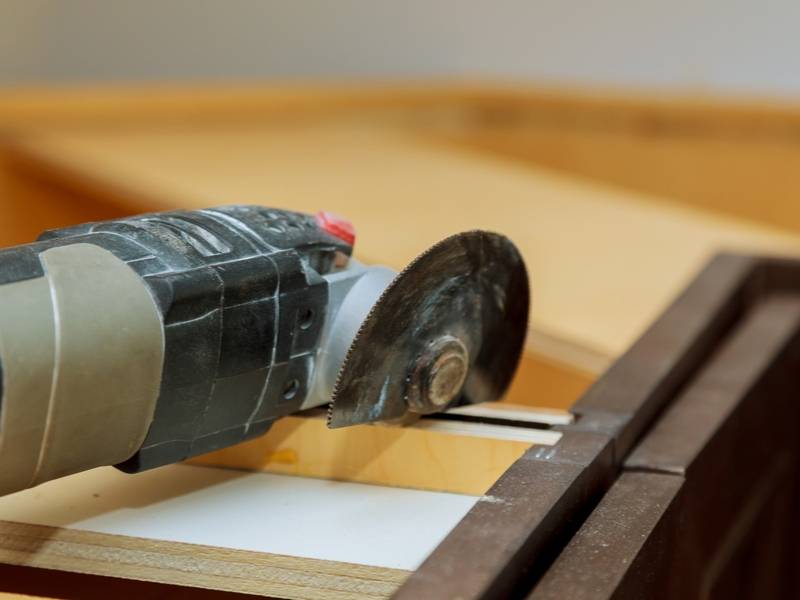Oscillating tools have become a permanent fixture in tool sheds across the country. Their many uses are sanding, cutting, compressing, and scraping. Additionally, they are used across the DIY spectrum for a variety of home improvement projects.
This type of tool is essentially a multifunctional oscillating head that moves back and forth around 20,000 times a minute. With a blade attachment, you can make highly precise cuts through even the most durable materials. Add sanding pads and you can quickly sand down a surface. A few years ago, you would have been hard-pressed to find them in a family handyman’s toolbox, but they have exploded in popularity recently to become a toolbox staple.
Before you head to the store to pick up your new oscillating tool, it pays to do a little research in advance. Don’t part with your money until you’ve read up on the best oscillating tools. Keep reading to learn about five things you want to know before purchasing a new oscillating tool.
Your Next Oscillating Tool • The Choices & Features

• Oscillating Saw
An oscillating saw is a versatile and powerful addition to any home toolbox, making it a must-have for DIY enthusiasts and homeowners alike. With its ability to cut, sand, scrape, and grind, this handy tool can tackle many projects, from trimming door frames and removing grout to cutting pipes and sanding hard-to-reach spots. Its compact size allows precision work in tight spaces, while the interchangeable blades make switching between tasks quick and easy. Whether tackling a major renovation or handling minor repairs, an oscillating saw can save you time and effort, proving to be a valuable asset for all your home improvement needs.
• Corded or Battery Powered?
The first thing to consider is whether you need a cordless or battery-powered operating tool. Both have their advantages and disadvantages. The corded option will never run out of power as it works off the mains. However, you are limited in mobility by the cord trailing you around.
Not only is this an annoyance, but it can also be a health and safety hazard. The cord trailing behind you causes trips and it is not unheard of for an over-enthusiastic handyman to have accidentally cut through the cord while working on a project.
• Available Replacement Parts
Blades and grinders are easy to wear out, particularly if you are using your oscillator for industrial purposes. Therefore, you will want to go with a manufacturer that uses a standardized mounting system. This will make it easier to source replacement parts such as blades and other accessories.
• Additional Features
Like anything, there are a host of bells and whistles that you can buy for your oscillating tool. For most, these aren’t necessary, but if you have a specific use for your oscillating tool in mind, it might be worth picking up one designed for the job.
For instance, roller guides are among the most useful additional features. They allow you to control the cut depth and help keep the tool steady when cutting or grouting.
• Variable Speed Control
If you frequently do small, detailed cutting work. It might be worth choosing an oscillating tool that has a variable speed control feature. Some will go as low as 10,000 OPM, which allows more control when cutting. Alternatively, if you are all over fast, rough cutting, something which goes up to 22,000 OPM will be better suited for your handiwork.
• Price Ranges You May Expect
Oscillating tools vary in price from as little as $30 to as much as $160. Unlike other products, there isn’t a big difference in how well they perform. Most oscillators can cut through durable materials with a high degree of control and accuracy. The price difference usually stems from the level of convenience and comfort offered by the product, as well as their reliability.
Less expensive oscillating tools are often big and cumbersome, making them poorly suited to cramped working conditions. They also break down sooner than the higher-end products on the market, leaving you having to replace them every few years. While these cheaper ones might be fine for the occasional DIY project around the house, if you are using your tool regularly it pays to invest some money.
Here’s to Your Successful Home Projects!
These are some great tips to follow when you purchase your next oscillating tool. Let us know in the comments below if you have any other tips to add to these. In addition, we’ve included some other links below to help you further with your home projects.
Post Image Courtesy of Canva.
Other Posts You Might Enjoy:
Top Woodcutting Tools for Your Designing Projects
DIY Home Repair; 8 Essential Tips





